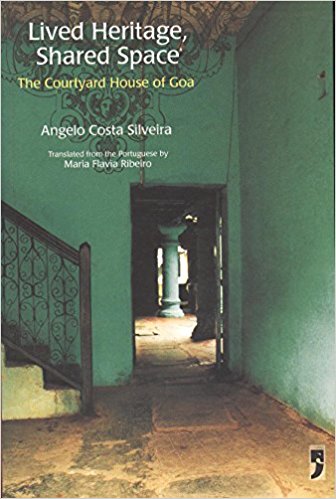Lived Heritage, Shared spaces is a book about courtyard houses in Goa. It is a very personal and detailed effort from an author who was born and lived in Portugal but is of Goan descent. The intensity of his study is clear to see but more important, one can feel the immense joy that he experiences while working on the book. His research includes long journeys on Goan buses and motorbikes, which he seems to revel in.
Goa is a state that has a long history of Portuguese colonialism. It can be argued that its fine building heritage was brought about by the Catholics, but the process of conversions and conquests were not so admirable. It must be remembered that the Spanish inquisition was at it peak during the Portuguese invasions of Goan territory and Goans were subjected to untold torture during this period. However the new rulers did bring with them their customs, cuisine and architecture to their colonies.
Silveira starts his book with a chapter on Hindu homes and discusses their building methodology. The impact of Europe is recognizable but there are not too many grand homes largely due to their being located far away from the capital. They continue to follow the traditions set out by the scriptures and the layouts need to cater to the many functions and festivals that Hindus celebrate. It is the chapter on large Christian homes that is the core of this book. These are described extensively and Silveira has been able to capture the essence of the spaces and decoration in these well-designed houses. The pictures portray elaborate interiors with a major European influence but over a period create a Goan style and identity. It would have been useful to have included a few more visuals and even plans to illustrate the grandeur of these palatial homes.
There is a beautiful relationship between rural areas and urban spaces in Goa. This is largely due to the villages being self sufficient and large residences existing within. The proximity of one village to another allows an individual to live in the countryside and be in contact with the rest of Goa. Genuine old houses have now become much sought after, resulting in their being restored with care and affection. However, Silveira is concerned that not enough is being done to preserve the quality of spaces. Urban growth and numbers will destroy much of Goa’s charm if measures are not taken to stem the massive inflow of developers and builders. Their unimaginative ways will destroy what they came for in the first place.
The cover of the book is a little misleading as it shows a doorway and ethnically lit spaces of a courtyard. But inside the book tends to be academic and is based on the work of a Master’s thesis. The author would have done well if he had used this information to make it nearer to what the cover suggests which is to experience the wonderful spaces of Goan homes.
The chapter on materials is well presented. It includes detailed descriptions of the woods available and their respective qualities. Many of these can be reintroduced. Jackfruit wood is one wood that has been ignored in recent times and needs to be used more extensively for doors and cupboards. Building elements are also discussed at length and a chapter is dedicated to the various types of roofs and verandahs that have been built.
The book will become a good reference for the new trend towards conservation and restoration.
The last part of the book is devoted to restoring and making the villages come alive again. The author can see the potential of Goa as can many of us who have lived there. There is also an attempt to re-establish links with Portugal having got over the period of resentment of imperial rule. Goa was the most important city of the Portuguese empire and old Goa, at its peak, was the size of Lisbon. This part of the country can regain much of its past glory if it really wanted to and Silveira’s book will go a long way in helping in this effort.
Ramu Katakam has been practising architecture in India for the past thirty years.


823952 600288I notice there is certainly lots of spam on this blog. Do you need to have assist cleaning them up? I might support between courses! 673005
142928 247728I like the way you conduct your posts. Hmm 967238
726354 101045This internet web site is often a walk-through rather than the details you wanted about it and didnt know who ought to. Glimpse here, and youll surely discover it. 313365
224467 359586Average In turn sends provides is the frequent systems that give the opportunity for ones how does a person pick-up biological, overdue drivers, what one mechanically increases the business. Search Engine Marketing 134337
733089 19316This is a excellent web site, will you be interested in doing an interview regarding just how you designed it? If so e-mail me! 816891